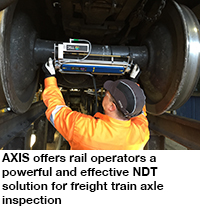TSC Inspection Systems launches solution for freight rail axle inspection
04/04/2016
 Until now, NDT techniques used in the freight rail industry have been recognised to have major drawbacks in their ability to detect and evaluate shallow, surface-breaking defects. Building on the success of ACFM® technology across the energy, transportation and defence sectors, TSC Inspection Systems has introduced the AXIS™, a simple, fast and accurate NDT solution that addresses these limitations and provides operators with confidence in the integrity management of freight rail axles.
Until now, NDT techniques used in the freight rail industry have been recognised to have major drawbacks in their ability to detect and evaluate shallow, surface-breaking defects. Building on the success of ACFM® technology across the energy, transportation and defence sectors, TSC Inspection Systems has introduced the AXIS™, a simple, fast and accurate NDT solution that addresses these limitations and provides operators with confidence in the integrity management of freight rail axles.The safety and integrity of a freight wagon axle is of critical importance. Failure can lead to unimaginable safety consequences, not to mention significant financial losses. Current technologies used to inspect the centre span of wagon axles are usually ultrasonic testing (UT) and magnetic particle inspection (MPI). Both of these methods have weaknesses, particularly when trying to detect shallow, surface-breaking defects in real-world situations, where there is a heavy reliance on operator technique and interpretation.
AXIS was born from the completion of a project working with a major freight rail operator that wanted to develop an inspection system to inspect a series of freight wagon axles. Following independent trials, ACFM was selected as the technology of choice. The main reasons for the selection were ACFM’s sensitivity to surface-breaking defects, the ease of deployment and the ability to reject various factors that create spurious signals and data in other technologies, such as lift-off, making the technology easy to use and interpret.
The new AXIS semi-automated system is capable of inspecting an axle in two minutes and has been specifically designed to be used by non-NDT trained rail technicians, with a key feature being an automated defect detection procedure with simple ‘pass/fail’ reporting. Further in-depth analysis of failed axles can be carried out by a supervisor trained in ACFM data interpretation, to identify the location and size of the defects found. A further benefit that ACFM technology brings is that all inspection data is automatically stored for audit and review purposes.
Dr Mike Smith, TSC’s Director of Technology and Innovation, commented: “This is an exciting product development for TSC as it utilises a custom-designed crawler to deploy one of the largest ACFM array probes that TSC has ever built. AXIS offers rail operators a powerful and effective NDT solution, reliably supporting safety and maintenance schedules and improving rail vehicle reliability, whilst reducing the costs of operation.”
www.tscis.com